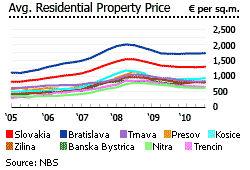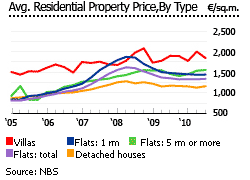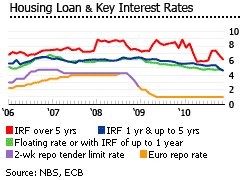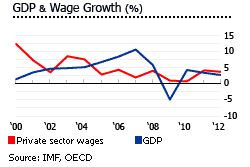House price falls slowing in Slovakia. Turnaround in sight?

Slovakia’s housing market remains depressed, with the economy slowing and unemployment high. But house-price declines have been slowing. In fact house prices rose during the latest quarter.
Average Slovakian residential prices fell by 0.64% to €1,240 per square meter (sq. m.) during the year to end-Q3 2012, the lowest annual decline since Q4 2008, according to the National Bank of Slovakia (NBS). When adjusted for inflation, residential property prices fell 4.13% over the same period. As of Q3 2012, house prices are down by 20% (-28% inflation-adjusted) from the peak of the boom in Q2 2008.
On a quarterly basis, property prices actually rose by 1.06% (0.77% inflation-adjusted) in Q3 2012.
- The average price of flats rose by 0.62% q-o-q to €1,298 per sq. m., down by 1.07% from a year earlier.
- The average price of houses rose by 2.46% q-o-q to €1,126 per sq. m, up by 2.09% y-o-y.
The national figures conceal local property price movements. The region of Nitra experienced the biggest price fall of 6.08% y-o-y to Q3 2012. Nitra region has the country’s cheapest housing, at €602 per sq. m. It was followed by Trencin (-5.65%) and Banska Bystrica (-2.08%).
Other regions with property price falls include Bratislava (-0.54%), Presov (-0.49%), and Trnava (-0.24%). On the other hand, property prices in Kosice increased 2.78%, and Zilina house prices increased 0.53% over the same period.
Bratislava region has the most expensive housing in the country, with an average price of €1,662 per sq. m. in Q3 2012.

The housing boom in Slovakia lasted from 2006 to Q2 2008, with rises ranging from 14% to 35% per annum. The surge stopped in late 2008, and since then prices have fallen continuously.
At end-October 2012, the total volume of provided mortgage loans in Slovakia was up by 5.94% y-o-y to about €6.33 billion, according to NBS.
In the third quarter of 2012, the economy grew by 2.2% from a year earlier. Economic growth is expected to slow to 2.7% in 2012, according to the country’s central bank. The ongoing eurozone debt crisis and the global economic slowdown are already weighing on the Slovak economy, which is highly dependent on exports.
Apartment prices haven’t fully recovered yet

During Slovakia’s property boom, apartment prices rose 87% between 2005 and 2008 (70% in real terms), increasing from €635 per square meters to €1,080 per square meters.
- Smaller apartments (one room units) rose 104% (85% in real terms) 2005-2008, to €1,239 per square metre
- 5-room apartment prices rose 56% (39% in real terms)
- Detached house prices rose 40% (27% in real terms) during the boom years from 2005 to 2008, with average prices increasing from €680 per square meters to €862 square meters.
- Villa prices increased a meagre 25% (14% in real terms).
Prices of smaller apartments fell most during the crash.
Slight improvements have taken place in 2010, although flats (in general) and villas remain weak.
AVERAGE RESIDENTIAL PROPERTY PRICES |
||||
CHANGE |
||||
| SLOVAKIA | ||||
| REGIONS | ||||
| Bratislava | ||||
| Trvana | ||||
| Nitra | ||||
| Trencin | ||||
| Zilina | ||||
| Banska Bystrica | ||||
| Kosice | ||||
| Presov | ||||
| PROPERTY TYPE | ||||
| Total flats | ||||
| 1 - room | ||||
| 2 - rooms | ||||
| 3 - rooms | ||||
| 4 - rooms | ||||
| 5 - rooms | ||||
| Total houses | ||||
| Houses | ||||
| Villas | ||||
| Source: National Bank of Slovakia | ||||
Lower interest rates

Slovakian interest rates gradually declined throughout 2010. By November 2010, average housing loans had fallen to:
- Floating rate, or fixed for up to 1 year: 4.68%,
- Fixed for 1 - 5 years: 4.64%,
- Fixed for 5+ years: 6.18%.
Meanwhile, the ECB repo rate has remained at 1% since May 2009
However as a reaction to the crisis, banks have become very cautious in their lending activities.
The economy

Slovakia is one of Eastern Europe’s most successful transition countries. Born in 1993 after seceding amicably from the Czech Republic (the two countries were formerly known as Czechoslovakia), it has a stable polity and liberal market economy.
Slovakia benefited from eight years’ reform under the centre-right coalition led by Mikulas Dzurinda (1998-2004) whose reforms won praise from international organizations, and who oversaw EU and Nato entry.
One of the most famous characteristics of the Slovak economy is its ‘flat tax’ of 19% on income, consumption, and corporate profits, operative since 2004. “It just works!” explained former minister of finance Ivan Miklos to a Cato Seminar.

The economy’s rapid growth facilitated the country’s membership of the Organization for Economic Cooperation and Development (OECD) and the European Union (EU) in 2004. In December 2007 Slovakia became a full member of the Schengen Zone, allowing passport-free travel in the 24-member European nations.
Real GDP growth reached an impressive 10.4% in 2007, following 8.2% for 2006, 5% for 2005, and 5.5% for 2004. Kia, Volkswagen, and Peugeot Citroen all have large car plants in Slovakia.
In 2008 there was 6.17% growth, and then a collapse with the crisis to a 4.66% GDP contraction in 2009.
Unemployment was 8.7% in Q4 2008, a significant drop from 19% in 2000. However, unemployment rose again to 14.1% in Q3 2010.
Smer-SD returned to power
In the March 2012 Parliamentary elections, Robert Fico returned to power and his Smer-Social Democracy (Smer-SD) won an absolute majority of seats, after the major corruption scandal (the Gorilla scandal) destroyed public confidence in the ruling coalition. PM Robert Fico has pledged to reduce the deficit, and raise revenues through tax hikes on companies and high earners. However Smter’s previous period in office gained it a poor reputation, partly because of its extremist allies, partly because of populist economics.
Former prime minister Iveta Radicova centre-right coalition, led by the Slovak Democratic and Christian Union (SDKU), had won power from Fico’s centre-left coalition in the June 2010 Parliamentary elections, and made restoring the country's public finances her government's main priority.
However Radicova lost a confidence vote in Parliament in October 2011 because of her government’s support for the European Financial Stability Fund, leading to the fall of her government.
Yields in Slovakia are unattractive
The decline in dwelling prices since 2009 has been accompanied by an even larger drop in rents, which has brought a decline in yields.
In Stare Mesto, Bratislava’s city centre:
- Gross rental yields on 80 sq. m. and 120 sq. m. apartments were around 4.63% and 3.88%, respectively, according to Global Property Guide research in July 2010.
- Yields on smaller units of 45 sq.m were higher, at 6.73%.
In Bratislava’s less upscale districts (Bratislava II & III), gross rental yields were between 4.57% and 6.30%.

This drop in rents is attributed to increased housing supply around Bratislava. During the last 5 years, around 2,500 to 4,000 units were build each year in Bratislava, according to REAS. Even in 2009, when the global recession occurred, 3,741 dwellings were built.
“Currently the primary residential market in Bratislava is a buyer’s market,” says REAS. However, many fewer completions are expected in 2010 and in 2011, due to limited access to construction loans and also because most developers focus on selling existing projects.
Limited rental market
Slovakia’s rental market is smaller than that of most other EU countries. Only 0.1% of Slovakia’s housing stock is let out by private landlords, mainly concentrated in Bratislava, largely due to the rent control system. Owner-occupancy has risen dramatically from 49.7% in 1990, to 88% by 2008. The share of co-operative housing fell to 7%, and the share of public rental housing to 5%.
Part of the growth of owner-occupation is due to a contractual savings system (Bauspar) that makes it easier for Slovaks to obtain housing loans. This Bauspar system allows borrowers to take loans at lower interest rates, and the government pays an interest premium on the amount saved.
In 2005, the government decreed the abolition of rent control, effective July 1, 2007. However, the decree was never implemented. Rent deregulation has been postponed repeatedly, as Parliament refuses to deal with the highly sensitive issue.
Slovakia’s mortgage market is small

Slovakia has one of the lowest mortgage-debt-to-GDP ratios in the EU, at 14.95% of GDP in 2009. Yet despite the downturn, loans for house purchases increased 12.09% y-o-y to Q2 2010, driven by lower interest rates.
At end-October 2012, the total volume of provided mortgage loans in Slovakia was up by 5.94% y-o-y to about €6.33 billion, according to NBS.